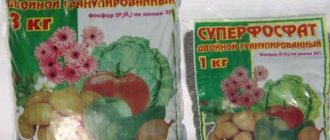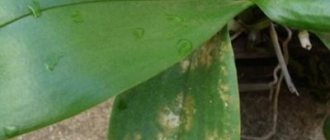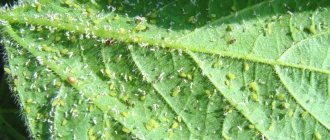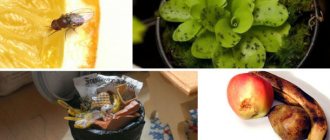Fighting mites on violets. What pests can live on violets. What they look like and what are the signs of infection. What harm is done to plants? Use of effective chemicals. Application of traditional methods. How to prevent infection.
We all know about pests that attack plants and cause great harm to flowers. When we notice that a violet begins to weaken without any reason, its leaves change color and shape, most likely a mite has settled on it. It is necessary to fight it as soon as the first symptoms of infection are noticed, since without taking any action, the pest can destroy the flower.
Next, we will find out what needs to be done if a mite appears on a violet, what chemicals and folk remedies can be used, and what preventive actions will prevent infection.
Ticks - what kind of “living creatures” are they?
There are many varieties of ticks. But it is Saintpaulia that is often affected by three types of herbivorous parasites:
- strawberry mite,
- transparent greenhouse,
- cyclamen.
By and large, there is no need to find out exactly what type of mite has infected your violet, since this can only be found out through careful examination under a magnifying glass. In any case, most acaricides (chemical anti-mite drugs) act on many varieties of these pests.
But you still need to know something about ticks:
- These are not insects, but arthropods. Products designed to kill insects may not work on them.
- Often, several types of mites appear on a flower at once.
- Organisms can develop resistance to poisons, so medications must be constantly changed.
- Ticks are very tenacious, it is better not to waste time on various folk remedies that may not work, but to immediately treat the flowers with chemicals.
- If the plant has been attacked by pests once, it is recommended that after treatment it is treated for prevention once every 2-3 months, since mites can go into long hibernation.
Description and appearance
Most often, the cyclamen mite appears on violets, which also affects other indoor plants. Azaleas, Kalanchoes, and cyclamen are at greatest risk of infection. But these pests harm not only indoor flowers, they also affect garden and vegetable crops. They have very small body sizes and it is simply impossible to see them on a flower without magnifying devices. They belong to the arachnids.
They have a translucent, oblong body, light yellow in color, and 8 legs. They live in buds and on young shoots. Their diet consists of plant sap. These pests multiply very quickly and within a few days after infection the colonies increase significantly.
One female lays 12 to 16 eggs daily, which require only 3-7 days to develop. A week after laying eggs, young individuals appear, which need nutrition and are ready for further reproduction. You can see what they look like in the photo.
Favorable conditions that contribute to their rapid reproduction are warmth and minimal humidity. Therefore, the peak of their activity for indoor plants occurs in winter, when apartments have heating. And for garden crops, such a favorable environment occurs in the summer, when hot and dry days arrive.
Other types of ticks
- Unfortunately, not only the cyclamen mite is dangerous for violets; plants can also infect other types of mites. One of them is a cobweb, which is no less dangerous and can lead to the death of a violet. These are small parasites that reach no more than 1 mm. In the warm season, they have a green body color, and in the fall and spring they change it to red.
- It is dangerous not only for violets; the pest affects berry and fruit crops. They also feed on plant sap. The product of their vital activity is a cobweb that envelops the flower, and it is by this that the infection can be determined. Acaricides and folk remedies are quite effective in combating it.
- Another dangerous species is the flat beetle; this mite affects violets, cacti, ficus, citrus fruits and other types of indoor plants. It has an ovoid body shape and can be yellow-orange or yellow-brown in color. When infected, the leaves begin to dry out, the plant weakens greatly and dies. Favorable conditions for reproduction are temperatures of 18-24°C, so they lay eggs all year round, which is why they pose a great danger. Acaricidal agents are used to combat them.
- Violets and root mites, as they are also called bulb mites, are not ignored. They infect plants underground; most often, orchids, gladioli, tulips, etc. are attacked by these pests. High humidity serves as favorable conditions for their reproduction. Bulbs should be stored only in dry rooms where the humidity level does not exceed 60%, which is an effective prevention.
Signs of defeat
Since it is impossible to see the pest on a violet, infection can be determined from the external signs that appear on the flower. Something similar to a dusty coating appears on young shoots, buds, as well as young green leaves. The mite infestation is most noticeable on the leaves, as they change color, become dull, a yellow tint appears, then they turn brownish-gray and the leaves become deformed.
The petioles and leaves become very dry and brittle. Also, thin hairs similar to cobwebs appear on young leaves. The buds do not open and begin to fall off.
If such signs are detected, it is necessary to relocate the infected flower so that the pests do not attack neighboring flowers. You will need to immediately resort to treatment methods.
Scale insect and false scale insect
This type of pest is dangerous because immediately after birth, scale insect larvae spread throughout the flower and begin to feed on violet juices. From their name you can understand that their characteristic feature is a small shield on their back. They prefer to spread on violet leaves. The larvae are very fast and can move to other plants, so as soon as you notice this pest on a violet, isolate the flower from others.
If a violet is affected by scale insects or false scale insects, you will notice the following signs:
• Violet leaves dry out and fall off. • A sticky secretion is produced that encourages the development of sooty fungus. • Yellow spots and brown plaques appear on the leaves.
If you notice these symptoms, start treatment immediately:
• Isolate the plant from all other flowers. • Be sure to rinse the plant in a warm shower. • Remove plaques with an alcohol solution or soap. • Treat the flower with a solution of water and machine oil, but be sure to rinse the plant after a day. Thanks to this solution, a thin film forms on the leaves, under which the scale insect will suffocate. • Change the top layer of soil. • Treat the violet with an insecticide (Fitoverm, Aktara).
The false scale insect enters the apartment only from another, new plant. For this reason, keep purchased flowers in quarantine. For prevention, inspect the flowers from time to time and wash them in the shower. The most important thing is proper care and hygiene.
Symptoms of mites on violets
The difficulty is that it can be difficult to understand why a violet is sick. These parasites are invisible, and their presence is indicated only by painful signs that can be confused with other causes.
And yet, we will try to highlight the main symptoms that are more characteristic of a tick-borne scourge:
- Saintpaulia leaves droop and the plant looks drooping.
- The petioles become brittle and sometimes fall off when touched.
- White, yellow, and brown spots may appear on the leaves.
- The edges of the leaves darken and curl.
- The plant does not bloom, and if there are buds, it does not bloom, quickly withering.
- The color of the leaves changes, becomes dull, and a coating appears on top.
- When you feel the leaves, you can feel the tubercles (deposited mite larvae).
- Flower growth slows down.
Note: mites love moisture, so they often nest in the rosette part of the violet closer to the soil. But if the plants live in greenhouses with high air humidity, then the parasites will be comfortable on any part of the violets.
General information
Members of the family Tenuipalpidae (flat mites) are close relatives of spider mites, for which they are sometimes called false spider mites . The main anatomical difference between these groups is that in spider mites the body is solid, while in flat mites it is divided by transverse sutures into several parts (anterior, middle and posterior).
Larva of the flat beetle Brevipalpus obovatus
Flower growers encounter representatives of two genera of flat mites - Brevipalpus and Tenuipalpus . Brevipalpus russilus (=Hystripalpus russilus, =Tenuipalpus cactorum) - the cactus flat beetle is a dangerous pest of cacti. Tenuipalpus pacificus severely damages orchids and ferns. It is sometimes called the phalaenopsis mite . Also pests of orchids are the oncidium flat mite (Brevipalpus oncidii) and the greenhouse flat beetle (Brevipalpus obovatus) . Various representatives of flat mites (the most famous, about 40) harm grapes, citrus fruits, palm trees, unabi, privet, ivy, milkweed, rosaceae, ficus and many other tropical and subtropical plants. Accurate identification of pests of this group is extremely difficult. There is no available definitive literature and no consensus on the taxonomy of these mites.
We will talk in detail about the greenhouse flat beetle - Brevipalpus obovatus , since it is the one that damages violets and other gesneriaceae. In Russian-language sources, this species can be called greenhouse flat beetle, common flat beetle, red flat mite, orange flat mite , etc.
Male flat beetle Brevipalpus obovatus
Female flat beetle Brevipalpus obovatus
Flat beetle Brevipalpus obovatus - side view
Detection and control measures
Among the most dangerous mites, the one that primarily attacks indoor plants is the cyclamen mite (Phytonemus pallidus). Its dimensions are measured in microns, so the parasite can only be seen under a microscope.
However, the mite affects not only cyclamens; it can seriously harm Saintpaulia, Gloxinia, Kalanchoe, balsams and other indoor plants. As a rule, larvae and adults settle at the growth point, while young leaves become deformed, wrinkled and covered with gray or brown fluff. Flowers do not bloom, buds fall off.
The cyclamen mite develops very quickly in warm conditions and high humidity. Severely affected plants appear as if covered in dust.
Ticks reproduce extremely quickly. The young generation can be formed every three weeks, and under suitable conditions even after two. Therefore, if infection is suspected, the affected plants should be separated and fenced off.
Detection of cyclamen mite
The presence of an uninvited guest can be judged only by indirect external signs. In Saintpaulia, the main thing to pay close attention to is the deformation of flowers, which take on an unusual shape, often do not open at all, fly around at the bud stage, and have an abnormal color. The shoot is deformed, fresh leaves are affected, and they curl in every possible way. Long hairs on young leaves are clearly visible.
In other plants, these mites also often provoke deformation and depigmentation of damaged plant organs. They lead to drying out and deformation of the shoots, and changes in the shape of the leaves. Flowers may develop spots and may not bloom. These pests love high humidity, so they usually settle in the folds of young leaves, in the buds, where there is more moisture.
Prevention of occurrence
Regarding prevention, there are no particularly effective methods in this case. The housewife must regularly monitor the general health of all her houseplants.
As soon as one of these signs is identified, the fight against the tick should be started in a timely manner. If this is not detected in time, then in addition to the death of the affected plant itself, all the flowers located in the house may fall into the danger zone.
Measures to combat the cyclamen mite
If there is a suspicion that a plant is infested with a mite, it must be immediately isolated from other flowers. If there are few infected specimens, then the parasite can be destroyed by treating the plants with warm water (up to 40–45 °C). All habitats of the parasite are removed from the affected flower and kept in water together with the pot for approximately 15 minutes, trying to maintain the required temperature throughout the treatment. The disinfected flower is moved to a warm place for 2-3 days, protected from the sun.
Significantly damaged specimens are easier to propagate from healthy lobes, and destroy everything else, preventing the spread of the parasite.
You can also fight the cyclamen mite with chemical means. When choosing a drug, it is necessary to take into account that ticks are not insects, and drugs to combat parasitic insects will not affect them. They should be combated with specialized means - acaricides.
A characteristic feature of pests is their fertility, which is why they quickly adapt to poisons. When destroying them, it is necessary to continuously change the drugs used. Acaricides must be used at least 3 times, each time using a different drug. This is explained by the fact that not all drugs act on all generations of parasites. The next time you use a new drug, you increase the likelihood of killing parasites of all ages. The most effective remedies are considered to be Sunmite, Neoron, Omite.
The products must be used outdoors or in non-residential premises with good ventilation. When treating the plant, you should also treat the soil in the pot. You can increase the effectiveness of the products if you place the treated plant in a plastic bag and wait at least eight hours.
Preparations that exterminate ticks are very toxic and pose a danger to humans; when using them, it is necessary to use personal protective equipment.
After completion of the treatments, flowers are placed in quarantine and kept away from other specimens. After about a month, when new shoots appear and no symptoms of mites are detected, the flower can be returned to its old place.
Podura (springtails)
Sometimes, on the surface of a damp substrate in a pot with a violet, springtails or podura settle. When the owner sees this insect for the first time, he literally freezes with horror - after all, tiny white or cream-colored insects with antennae are crawling in the pot under the flower. There are specimens painted in a greenish or silvery tint. The average size of a podura is approximately 2 mm, but there are also large specimens, up to 1 cm in length. Some of them crawl, others also jump with the help of a special fork attached to the underside of the abdomen. By the way, this feature (jumping) distinguishes springtails from the larvae of other insects - mealybugs, fungus gnats and thrips.
In fact, poduras in small quantities are not dangerous for indoor plants, including violets. They are part of the natural soil fauna. Poduras settle on the surface of the ground, love dampness and readily reproduce in it. Poduras feed on plant particles that begin to rot. We recommend immediately reducing watering the plant. Indeed, during overflow, when water stagnates on the surface of the substrate, forming silt, “uninvited guests” form a mass population and become a problem for both the flower and its owner. Particularly large specimens of springtails can damage young Saintpaulia seedlings, and at low room temperatures, minor damage can cause various infections.
This may be interesting: Spathiphyllum - how not to miss Women's happiness
To remove the fungus, you should sharply reduce watering of the plant. Pay attention to the composition of the substrate - it should not contain components that cause the development of fungi and mold: sawdust, tea leaves, dry leaves. Deprived of their usual comfortable habitat, springtails will disappear on their own and will stop bothering your violets.
Another folk method against fools. Place the pot with the flower in a basin and fill it with settled warm water “over the top”. When the springtails float to the surface of the water, you will collect them with something like a strainer.
Regular raw potatoes, cut in half, will help to collect springtails. Place both halves cut side down on the surface of the substrate for several hours. All the springtails will gather on the potato cuts. All you have to do is carefully lift the halves from the ground, holding them with a flat spatula from below, in order to collect all the individuals and destroy them. This procedure will have to be carried out several more times until you are sure that you have gotten rid of all the individuals.
If the colony of springtails has become too numerous, we recommend treating the plant with insecticides. The drug Bazudin is suitable. It is scattered over the surface of the substrate in a thin layer. The fools will probably die within a few hours. The drug Pochin will cause a similar effect. Only its granules should be mixed with the soil. It will begin to act immediately, and in a few hours all insects will be destroyed. You can also treat the soil with a solution of Mospilan, Aktara, Pyrethrum according to the instructions. But the main thing is to dry the soil optimally.
Fighting methods
There are many ways to combat this microscopic pest. You can use specialized chemicals or seek help from traditional methods.
Traditional methods
The most effective methods include bathing the violet at a certain water temperature. The procedure is as follows; at the first stage, you will need to remove severely affected leaves. Next, take a container and pour water at a temperature of 45°C into it. You will need a thermometer, since this method is effective precisely at this temperature; if it is higher, then you can harm the plant, and if it is insufficient, then the procedure will not bring any effect.
Next, you need to immerse the flower completely in water for 15 minutes. It is also necessary to maintain the correct temperature during the procedure. After the water procedure, it should be placed in a shaded place, and after a few days it can be returned to its original place.
Chemicals
As with traditional methods, a mandatory step is to remove the affected parts. Most often, acaricidal agents are used for treatment, which must be used to wipe the violet leaves. These include Akarin, Fitoverm, Aktofit, and others. Wiping is carried out every 3 days, then the time intervals are increased to 5. When the bush is very infected, they do not use wiping, but bathing, when the flower is completely immersed in the solution.
If we talk about insecticides, they are ineffective against pests. This is because ticks develop immunity to the active ingredients; in addition, the products are not capable of destroying egg laying. When carrying out treatments with acaricides, it is necessary to carry out several procedures in which the products are changed.
Antiklesch, Omite, Kleschevit, Neoron show fairly good effectiveness. But remember, treatment with these products should not be carried out in an apartment. After the procedure, the violet is covered with plastic wrap for up to 24 hours. The drugs are toxic and when using them, protective equipment must be used.
Use of chemicals
The first step in treating mites should be the complete elimination of all affected parts of the plant and infected flower stalks. Then it is necessary to wipe the leaves and other green parts of the violet using acaricidal agents: Actofit, Fitoverm, Akarin, Agravertin. To completely get rid of ticks, the procedure must be repeated every 3 days, and then every 5 days. If the damage is severe, it is recommended to completely dip the violet bush into a solution with acaricide or avermectin agents.
On a note!
Popular chemical insecticides have no effect on ticks at all. Arthropods very quickly develop resistance to the poison, and it does not destroy their eggs - they can remain viable for several years.
Chemical measures to combat ticks involve frequent changes of drugs to increase the effectiveness of the fight and reduce addiction to them. Therefore, treatment with acaricides should be carried out in several stages, changing the drug each time.
Such drugs as Kleschevit, Antiklesch, Neoron, Sunmite, Omite have a good effect on ticks. However, the treatment should be carried out in a non-residential area, and after spraying the violets should be covered with polyethylene for 8-24 hours.
Chemical pest control
Due to the high toxicity of these drugs, it is necessary to use personal protective equipment (respirator, gloves and protective clothing).
Precautions when processing violets:
- Do not prepare the solution in containers intended for food;
- there is no need to add soap, since alkalis are incompatible with avermectin products;
- all prepared solutions should be used quickly, and then the remains should be destroyed;
- Treatment cannot be carried out in a residential area - it is dangerous for the health of people and pets.
Important!
After processing and treatment, the violet bush must be quarantined, that is, isolated from healthy specimens. And only after 3-4 weeks, after the appearance of fresh shoots and the obvious absence of signs of mites, the flower can be moved to its usual place.
Anti-mite treatment
How to treat : everything is simple and straightforward - the plant must be thoroughly sprayed with the preparation until it is “very wet”, so that not a single untreated square millimeter of surface remains on the entire plant, and not just on the leaves. Just like that, casually spraying on the leaves “for prevention” is an empty and useless exercise. In general, treatments for preventive purposes have the same basis and meaning as drinking medicine by a healthy person in order to prevent a disease. Drug treatments are not plant vaccination; they only make sense if a pest is present.
The frequency and frequency of treatments with avermectins and any preparations in general depend on the type of pest (the time of reproduction of the pest from egg to egg, the presence of periods of non-feeding of the larvae, etc. are taken into account). In turn, the development time of the mite depends on the ambient temperature, which must also be taken into account for the correct choice of treatment schedule. The minimum period between treatments is 3 days, selected at a temperature of about 30*C, when the mite reproduces as quickly as possible. At a temperature of about 20*C, treatments can be carried out after 5 days, but their number remains the same - at least three, and it is better to do four treatments. And, of course, treatments with avermectins lose their meaning at temperatures below 18*C, at which mites stop feeding and go into diapause.
By the way, when treating with Fioverm, it is reasonable to minimize the penetration of the drug into the soil; the roots, if the drug flows abundantly into the ground, may suffer from the alcohol contained in the drug.
Basic methods of struggle
Traditional methods do not destroy mites on violets, but only stop their development. However, before treating violets against mites with chemicals, make sure they are properly cared for.
In order to completely rid Saintpaulias of pests, it is necessary to provide them with optimal conditions:
- temperature no more than +24 °C;
- air humidity more than 45%;
- lighting about 2500 Lux;
- daylight hours 10-12 hours;
- optimal watering;
- loose soil not overfed with nitrogen.
In cases where it is impossible to provide the flowers with a lower temperature and high humidity, it is necessary to provide the violets with weekly water treatments. Except for those specimens that have rotten leaves or the plant has lost turgor.
The leaf blades of adult violets should be washed from the underside with warm running water. You need to feel the small tubercles, which are nothing more than egg-laying sites, and remove them. The leaf plates bent inward must be carefully straightened and washed, as mites are located there.
Try to avoid getting water into the growing point. If this happens, blot the moisture well with paper napkins. Washed plants should be allowed to dry in a warm, dark room.
Running water helps get rid of tick nests.
But the most reliable and effective way to get rid of ticks is to treat Saintpaulia with acaricides. These drugs are divided into 3 groups:
- contact acaricides that penetrate the tick’s body through the skin;
- intestinal acaricides acting on insects through the mouth;
- systemic acaricides impregnate the roots and leaves of plants, making it poisonous to pests.
It is best to use a drug that immediately affects adults, nymphs and eggs. In this case, one tick treatment is enough.
It has now become possible to purchase drugs that are responsible not only for the complete destruction of pests in one treatment , but also do not pose a danger to people and pets. In addition, they are completely odorless. Here's how to treat violets against mites using the following preparations:
- Sunmite;
- Starmite;
- Mobento;
- Doni getter.
How to get rid of a tick if you couldn’t buy such drugs? In this case, it is necessary to take acaricides with different active ingredients , since mites very quickly acquire resistance to one drug.
In this case, violets will have to be processed at least 3-5 times every 7-10 days.
In addition to processing the Saintpaulia, it will be necessary to process not only the place where it was located, but also the other plants standing next to it.
Main pests of violets
Mealybug
Mealybugs are scale insects 3-6 mm in size, covered with white fluff. Visible to the naked eye in leaf axils, in young buds and on young leaves.
Mealybug.
Damaged surfaces leave behind a white coating resembling cotton wool.
Both adults and larvae are dangerous.
More detailed information about mealybugs with photos and the fight against them is discussed here.
Thrips
Adult thrips are dark-colored flying insects measuring 1-1.5 mm; the larvae are small yellow.
They damage the leaves, leaving white stripes, as well as the buds, leaving a scattering of pollen; the flower blooms with damaged anthers.
Thrips.
Brown or black spots appear on the leaves and flowers of the plant.
More information about the fight against thrips is written here.
Ticks
Ticks are microscopic in size and impossible to see with the naked eye. Violets are usually affected by the following types of mites:
- arachnoid;
- cyclamen;
- flatfish.
Mite on a violet.
Ticks feed on violet juice, as a result of which the foliage curls, droops, practically stops growing, and has a dusty appearance. The growing point takes on a grayish tint. The buds become deformed and do not open.
More details about ticks with photographs and their treatment are written in this article.
Aphid
Aphids primarily harm flowering plants. These small green insects are visible to the naked eye and form colonies in buds or on the inner surface of leaves.
Aphid.
Aphids feed on plant sap. After an aphid attack, the leaves become deformed and wither. White sticky aphid secretions appear on the plant.
You will learn more information about aphids with photos and how to treat violets from this insect in this article.
Midges
Midges and mosquitoes (sciarids) are insects that, as a rule, do not harm Saintpaulia.
The danger comes from larvae that destroy the soil, making it more dense and making it difficult for air to penetrate, resulting in damage to the root system.
Sciarid fly.
If the population of adults grows, they will begin to feed on violet leaves and petioles.
You will learn what to do if violets are infested with midges from the video at the end of our article.
Nematodes
Nematodes are 2 mm worms that live in the soil. Nematodes damage the roots of the plant, sucking juices from them and at the same time releasing harmful substances. In places of damage, harmful formations (galls) are formed.
Nematode.
To detect the parasite, you need to remove the plant from the pot and examine the root system.
Woodlice
Woodlice are small land crustaceans that resemble small white armadillos in appearance. They quickly increase their population, while feeding on the roots and leaves of Saintpaulia.
Woodlouse.
They pose a particular danger to children and starters. Woodlice are nocturnal, which is when they can be seen with the naked eye.
Shchitovka
Scale insects and false scale insects are similar in appearance, similar to a small shield. To distinguish them, you need to try to remove them from the plant, in which case the shield of the scale insect will come off, and the false scale insect will come off along with the shield.
Shield.
Both adults and larvae cause harm by feeding on violet juice and secreting a sticky liquid. They live on leaves or petioles.
Springtails and springtails
Springtails and springtails live on the surface of the ground and, in principle, do not harm violets.
Their size is 2-4 mm, the color is white, cream, sometimes greenish. In the back of their body they have a growth that looks like a small fork, and it is with its help that they jump.
Springtails.
During mass dispersal, young roots of Saintpaulia can be damaged.
Methods for controlling mites on flowers
The fight against cyclamen mite on violets can be done in various ways:
- use of folk recipes;
- use of chemicals.
The most popular folk remedy is to immerse the affected violet bush in hot water at a temperature not lower than 45°C. All affected parts of the flower must first be removed. The duration of the “bathing” is 15 minutes, but it is necessary to maintain a constant water temperature at the desired level.
After the water procedure, the bush is placed in a shaded place to allow it to recover for several days. Then it can be returned to its original place.
Thrips
Thrips on violets also like to feed on sap. These are small flying “insects” of a dark brown color. They have a wide range of attacks on indoor plants, including eating foliage. Thrips carry causative agents of various violet diseases from outlet to outlet, so they are very dangerous for indoor crowded plantings. You will see their presence by white stripes, brown or black spots on gnawed leaves and flowers. You can try to collect thrips by hand, but it is better to treat the flower with preparations such as Fitoverm, Actellik or Aktara. It is necessary to process not only the violet leaves, but also the substrate. Pick off flower stalks - Saintpaulia pollen is a favorite food of thrips.
This may be interesting: Gardenia Jasmine - home care
Prevention measures
Before taking urgent measures to destroy the pest colony and save Saintpaulia from death, it is necessary to carry out preventive measures:
- immediately treat a newly purchased violet with an acaricide and quarantine it for 3 weeks - this is how much time passes from the moment of infection until the tick turns into an adult. This applies to stepchildren and cuttings. After processing, put the latter for rooting;
- maintain plants in accordance with optimal conditions;
- remove dry, old and rotting leaves and flower stalks;
- wash Saintpaulias in the shower in the heat;
- do preventive treatment with acaricides before critical seasons;
- Do not place flowers close to each other.
Advice! If it was not possible to avoid mite damage and it is necessary to save this variety, then after treating it with an acaricide, try to root the cuttings. Try to select a leaf without traces of infection. To prevent fungal diseases, treat planting material with a fungicide.
Prevention of insects affecting indoor Saintpaulias
To avoid the spread of insects to all your plants, just take simple measures:
Have you treated Saintpaulias for pests?
RegularNo
For all new violets, quarantine conditions must be created for 14-20 days. Spraying with chemicals is not necessary. If no signs of insect activity are found within the specified period of time, you can safely put the violet on the shelf along with the others. It is not recommended to place flowers plucked from the flower bed next to the violets. To prevent insects from crawling from a diseased violet to a healthy one, the plants should not touch their leaves. Regular wet cleaning of the premises is the key to the health of violets. This helps maintain the required humidity and prevents insects from moving along with the dust. Pots and trays must be disinfected before use. Before replanting, any soil, even purchased soil, must be sterilized. Garden soil should absolutely not be used as a substrate for growing violets due to the presence of many microorganisms in it. It is better to collect soil in the forest.
- From time to time it is necessary to bathe the plant. This allows you to wash off adult insects and their larvae from violet leaves.
- Withered leaves and faded buds must be pruned in a timely manner
Saintpaulias not blooming? There may be several reasons for this; we will discuss them in detail in our next article.
Failure to comply with proper care conditions (temperature, humidity, lighting), as well as frequent watering, weakens the plant.
In this state, it cannot resist attacks from parasites.
Amateur flower growers always want to protect their plants from pests. Unfortunately, this is not always possible.
Therefore, it is very important to know methods of dealing with uninvited guests. The tips given in this article will help in the fight against the main insects that can ruin violets
And so as not to have to use them, do not forget about preventive treatments of the plant and timely transplants.











